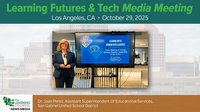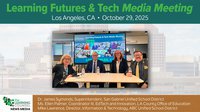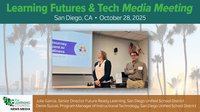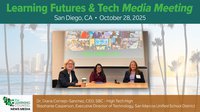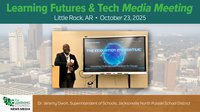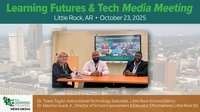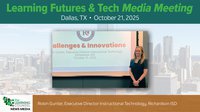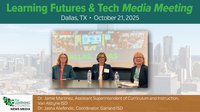The breakneck pace of Artificial Intelligence is set to reshape many aspects of our lives. Schools are not immune to these effects. How do we ensure that they do not become relics of the past?
Incremental refinements to existing systems may once have sufficed, but the speed of technological and cultural evolution calls for a fundamentally new approach to innovation in education. We can no longer rely solely on adding efficiency to outdated methods. We need a strategic framework that empowers us to operate effectively in the present, willingly discard what no longer serves us, and build a more daring, forward-looking model of schooling.
Can We Learn Anything from the Business World?
It may seem unusual to look for a business framework to guide us in education. Quarterly profits or product launches do not drive education. Yet the fundamental challenges businesses face—disruption, growing competition, and shifting demands—are no strangers to the educational sector. Schools worldwide are experiencing deep transformations: AI technologies are posing existential questions about our assessment systems and even the future role of the teacher. Global market demands require skill sets that scarcely existed a decade ago, and cultural shifts press for more inclusive, personalized learning. The world is in a state of flux. Educational leaders must adopt bold strategies that will ensure their leadership in the future. This is precisely where the Three Box Solution excels.
The Three-Box Solution
Developed by innovation expert Vijay Govindarajan, the Three Box Solution is a strategic framework that addresses three temporal dimensions of any organization. Box 1 involves managing the present, Box 2 consists in letting go of the past, and Box 3 consists in creating the future.
Box 1: Excelling in the Present
Box 1 represents the here and now—the engines that keep a school running daily. This includes traditional subjects, standardized assessments, traditional teaching methods, and well-established administrative processes in many educational systems. Incremental improvements are “linear innovations”: refining processes and incorporating new tools that make day-to-day practices more efficient. These changes can be powerful.
Focusing solely on Box 1 creates a trap. Placing all attention on improving our existing models risks irrelevance as the outside world evolves. For example, schools can use AI to differentiate materials quickly, but if the goal remains to raise test scores tied to an outdated curriculum, they are only honing yesterday’s solutions for tomorrow’s challenges. Box 1 innovation is necessary—but not sufficient. It stabilizes the present and frees resources for more ambitious transformations.
Box 2: Letting Go of the Past
Box 2 is about pruning away traditions, methods, and structures that no longer serve the ultimate mission of education. This can be the most emotionally tricky step because it requires leaders, teachers, and policymakers to question long-cherished practices. Do rigid curricula and standardized tests reflect the skills that students need in an era of AI-augmented creativity, critical thinking, and adaptability?
By letting go of what no longer fits, we gain the freedom to envision what could be a stepping stone to Box 3.
Box 3: Creating the Future
This is where transformative innovation lives. Box 3 innovation is not about making current systems more efficient but fundamentally rethinking what education can and should be. This might involve reimagining the curriculum in the AI era to emphasize interdisciplinary learning, creativity, empathy, entrepreneurial thinking, and advanced digital literacy.
Creating the future also means building institutional capacity for ongoing experimentation. Schools might establish “innovation labs” or pilot programs that test new pedagogical models, measure outcomes and iterate rapidly. Educators can partner with technologists and community stakeholders to identify weak signals of emerging trends—breakthroughs in AI, shifts in cultural values, or unprecedented global events—and respond proactively rather than reactively. Leaders who excel in Box 3 welcome uncertainty and see it as an opportunity to design something better.
The Interplay of All Three Boxes
The boxes do not operate in isolation. Their real power emerges when they work in harmony. The success of Box 3 innovation depends on resources freed by Box 1 efficiency and on the conceptual room created by Box 2 abandonment of outdated ideas. Without a well-run present (Box 1), a school lacks the stability to allocate resources to future-oriented projects. Without letting go of the past (Box 2), there is no space for the entirely new ideas to build tomorrow’s models. The Three Box Solution encourages leaders to maintain equilibrium among these dimensions.
Harnessing EdTech to Drive Innovation
Emerging technologies are disrupting how we think about education’s future. They also provide powerful tools to support schools in their journey through the Three Box Solution. Rather than functioning as a bolt-on afterthought, EdTech can serve as the connective tissue linking Boxes 1, 2, and 3, ensuring that schools can manage the present more efficiently, shed outdated practices,, and build the future more boldly.
EdTech's Role In Innovation
EdTech can improve operational efficiency, streamline administrative tasks, and practically enhance teaching and learning. This immediate, incremental improvement fits comfortably within Box 1’s objective.
AI-driven assessments can offer instant feedback and enable educators to adjust instruction in real time. By using EdTech to refine existing teaching methods, schools can free up resources, time, and energy to focus on more transformative goals. EdTech, at this stage, makes the current model more efficient and responsive, laying a stable foundation upon which more profound innovation can rest.
The lasting promise of EdTech emerges when looking toward Box 3. EdTech can facilitate the building of entirely new models of education for an AI-driven world. EdTech can allow schools to leverage global resources, connect students with experts and mentors from around the world, and deliver immersive, experiential learning that breaks traditional classroom boundaries.
VR and augmented reality (AR) tools can bring distant historical periods, remote ecosystems, or advanced manufacturing processes to life. Students can “travel” virtually to different countries, work collaboratively with peers in diverse cultural settings, or conduct scientific experiments in simulated environments that would be too dangerous, expensive, or impossible to recreate in a physical classroom. These experiences cultivate empathy, global awareness, and adaptable thinking. These are key competencies for a rapidly evolving world.
AI-driven tutoring systems can personalize the learning experience at scale, ensuring each student receives guidance appropriate to their current level and learning style. Meanwhile, analytics platforms can identify emerging skill gaps and predict future learning needs, helping educators proactively adjust curricula. EdTech provides the infrastructure for these novel models, assisting schools to incubate prototypes of what might become the norm in the decades ahead.
Designing the EdTech Ecosystem for Continuous Innovation
For EdTech to genuinely support innovation, schools must approach it not as a series of one-off purchases but as part of a long-term strategic vision. This requires building a coherent EdTech ecosystem aligned with the principles of the Three Box Solution. Just as leaders must balance present operations, disposal of outdated practices, and creating new models, they must also consider which technologies best serve each goal.
EdTech as a Catalyst for Cultural Change
Integrating EdTech effectively also shifts the cultural mindset within schools. By embracing new digital tools, teachers and administrators model adaptability, lifelong learning, and the value of experimentation. Rather than perceiving technology as a threat or a distraction, educators who see its potential learn to view it as an amplifier of human creativity and problem-solving capacity.
The ultimate goal is not to adopt technology for technology’s sake but to use it as a lever for genuine, sustained innovation. Over time, the EdTech ecosystem should help schools become more agile and future-focused. The same infrastructure that supports current lessons (Box 1) should enable the graceful phasing out of outdated approaches (Box 2) and the development of entirely new educational models (Box 3).
The key is to maintain a mindset of learning, adaptability, and readiness to explore new frontiers. EdTech is never a final answer but a constantly evolving resource that, combined with human ingenuity and ethical leadership, helps ensure education remains relevant and empowering.
New Mindsets and Leadership Imperatives
Leadership that thrives in this environment is transparent, mission-driven, and deeply committed to student success. It sets precise criteria for resource allocation, ensuring that the institution’s present needs do not eclipse the urgent task of preparing for an uncertain future. It also provides educators professional development and support to navigate this complex landscape. By fostering a culture where risk-taking is encouraged, and failures are seen as learning opportunities.
An education system guided by strategic innovation ensures that future generations are prepared to cope with emerging technologies and shape their ethical and creative uses. Educators, leaders, and policymakers must adopt a balanced, strategic approach that optimizes the present, courageously sheds the past, and actively creates the future. EdTech stands as a crucial ally—enhancing current practices, helping discard outdated methods, and enabling the invention of educational models that will equip learners for an age defined by AI, complexity, and boundless opportunity.
About the author
This book draws upon themes from Dan Fitzpatrick’s new book ‘Infinite Education: The Four-Step Strategy For Leading Change In The Age Of Artificial Intelligence’ out on January 6, 2025
Dan Fitzpatrick is one of the world’s foremost voices on AI in education. The bestselling author of The AI Classroom and the new book Infinite Education, he has empowered
100k+ educators and leaders worldwide to embrace innovation. An award-winning strategist and regular media contributor, Dan’s mission is to help schools prepare the next generation for success in a rapidly changing world. Discover more at theaieducator.io



